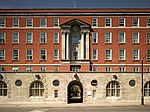Royal Albert Hall Organ
Individual pipe organsRoyal Albert Hall

The Grand Organ (described by its builder as The Voice of Jupiter) situated in the Royal Albert Hall in London is the second largest pipe organ in the United Kingdom, after the Liverpool Cathedral Grand Organ. It was originally built by Henry "Father" Willis and most recently rebuilt by Mander Organs, having 147 stops and, since the 2004 restoration, 9,999 pipes. An anonymous user publishes a tongue-in-cheek Twitter account supposedly written by the organ at @AlbertHOrgan.
Excerpt from the Wikipedia article Royal Albert Hall Organ (License: CC BY-SA 3.0, Authors, Images).Royal Albert Hall Organ
Kensington Gore, London Knightsbridge
Geographical coordinates (GPS) Address Website Nearby Places Show on map
Geographical coordinates (GPS)
| Latitude | Longitude |
|---|---|
| N 51.500719444444 ° | E -0.17736944444444 ° |
Address
Royal Albert Hall (Albert Hall)
Kensington Gore 4
SW7 2AP London, Knightsbridge
England, United Kingdom
Open on Google Maps








